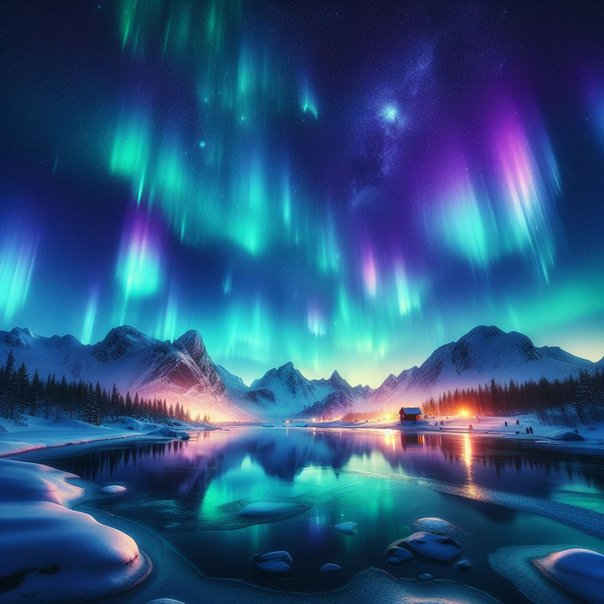
Experience the mesmerizing beauty of the Northern Lights, also known as the Aurora Borealis. Discover the science, best viewing spots, and tips for witnessing this natural wonder.
Witnessing the Northern Lights is more than just a visual spectacle; it’s an experience that touches the soul and connects us to the vastness of the universe. So, pack your bags, venture to the polar regions, and let the Aurora Borealis illuminate your night with its celestial dance. #AdventureAwaits #ExploreTheWorld #NatureLovers #TravelGoals
Discover the Northern Lights, also known as the Aurora Borealis. Learn about the science, best viewing times, top destinations, and tips for an unforgettable aurora experience. #NorthernLights #AuroraBorealis #TravelTips #NatureWonders #PolarRegions
The Northern Lights, scientifically known as the Aurora Borealis, are one of nature’s most spectacular phenomena. These shimmering lights, dancing across the polar skies in hues of green, purple, and blue, captivate all who witness them. This celestial display is not only a breathtaking sight but also a fascinating interplay between the sun and Earth. Let’s dive into the enchanting world of the Northern Lights, uncover the science behind them, explore the best places to view them, and learn how to enhance your viewing experience.
Understanding the Aurora Borealis: What Are the Northern Lights?
The Northern Lights are a natural light display predominantly seen in high-latitude regions around the Arctic and Antarctic. Named after the Roman goddess of dawn, Aurora, and the Greek name for the north wind, Boreas, the Aurora Borealis illuminates the night sky with vibrant colors.
The Science Behind the Lights
The captivating display is caused by charged particles from the sun, known as solar wind, interacting with the Earth's magnetic field. When these particles collide with gases in the Earth’s atmosphere, primarily oxygen and nitrogen, they emit light. The different colors—green, purple, blue—depend on the type of gas and the altitude of the collisions. Green, the most common color, results from oxygen molecules about 60 miles above the Earth. Purple and blue hues are due to nitrogen, typically at higher altitudes.
The Best Times to See the Northern Lights: When to Plan Your Trip
Timing is crucial for witnessing the Northern Lights. They are visible from late September to early April, with peak viewing times between December and March. During these months, the nights are the longest and the skies darkest, providing the best conditions for observing the lights.
Optimal Viewing Conditions
Clear, dark skies are essential for seeing the Aurora Borealis. The lights are more vivid in rural areas, away from city lights. A moonless night also enhances visibility. Checking the aurora forecast, which predicts solar activity and geomagnetic conditions, can help plan the best time to watch.
Top Destinations for Aurora Viewing:
Iceland: The Land of Fire and Ice
Iceland offers some of the most accessible and breathtaking locations to see the Northern Lights. Popular spots include Thingvellir National Park, Jokulsarlon Glacier Lagoon, and the Westfjords.
Norway: The Aurora Capital
Tromsø, in Northern Norway, is often referred to as the “Aurora Capital of the World.” This region provides stunning views and a variety of activities like dog sledding and Sami culture tours.
Canada: Vast and Untouched Wilderness
The Yukon, Northwest Territories, and parts of British Columbia and Alberta offer excellent aurora viewing opportunities. The town of Whitehorse in the Yukon is particularly famous for its vibrant displays.
Alaska: Majestic and Remote
Fairbanks, Alaska, is one of the top places in the United States to witness the Northern Lights. The city’s clear skies and proximity to the Arctic Circle make it an ideal spot.
Tips for an Unforgettable Aurora Experience
Prepare for the Cold
Winter nights in the Arctic can be extremely cold. Dressing in layers, wearing thermal clothing, and bringing hand warmers can ensure a comfortable experience.
Bring the Right Gear
A good camera with manual settings and a tripod is essential for capturing the beauty of the Northern Lights. Practice night photography techniques beforehand to get the best shots.
Be Patient and Flexible
The Northern Lights are unpredictable. Sometimes, it takes hours of waiting or even multiple nights to catch a glimpse. Stay patient and be ready to adjust your plans based on the Aurora forecast.
Aurora Myths and Legends
Cultural Significance
The Northern Lights have inspired countless myths and legends. Indigenous cultures in the Arctic often view the lights as spiritual phenomena. The Sami people of Scandinavia believed the lights were the souls of the dead, while Inuit legends describe them as spirits playing celestial games.
Modern Interpretations
Today, the Aurora Borealis continues to inspire awe and wonder. It is a symbol of the Earth’s natural beauty and the mysteries of the universe. The lights remind us of the delicate balance between the sun and our planet.
Preserving the Northern Lights
Environmental Considerations
The increasing popularity of aurora tourism brings environmental challenges. Respecting local communities, minimizing light pollution, and supporting sustainable tourism practices are crucial for preserving the natural beauty of aurora-viewing sites.
Educating others about the Northern Lights and the science behind them can foster a greater appreciation for this natural wonder. Sharing your experiences and photographs can inspire others to witness and protect this incredible phenomenon.
The Northern Lights, with their mesmerizing dance of colors, are a testament to the wonders of our planet and the universe. Whether you are a seasoned traveler or a curious observer, witnessing the Aurora Borealis is an unforgettable experience that inspires awe and reverence for nature’s splendor. Plan your trip, prepare well, and immerse yourself in the magic of the Northern Lights.
